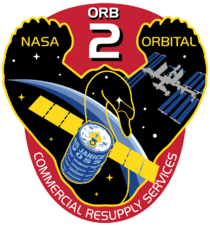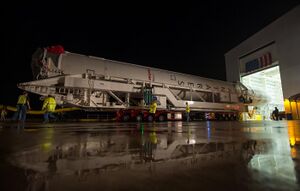Engineering:Cygnus CRS Orb-2
 Cygnus CRS Orb-2 arriving at the ISS on 16 July 2014 | |
| Mission type | ISS resupply |
|---|---|
| Operator | Orbital Sciences |
| COSPAR ID | 2014-039A |
| SATCAT no. | 40084 |
| Mission duration | 34 days, 20 hours, 29 minutes |
| Spacecraft properties | |
| Spacecraft | Cygnus 3 |
| Spacecraft type | Standard Cygnus[1] |
| Manufacturer | Orbital Sciences Thales Alenia Space |
| Launch mass | 5,644 kg (12,443 lb)[2] |
| Payload mass | 1,494 kg (3,293 lb)[3] |
| Start of mission | |
| Launch date | 13 July 2014, 16:52:14 UTC[4] |
| Rocket | Antares 120[1] |
| Launch site | MARS LP-0A |
| Contractor | Orbital Sciences |
| End of mission | |
| Disposal | Deorbited |
| Decay date | 17 August 2014, 13:22 UTC |
| Orbital parameters | |
| Reference system | Geocentric |
| Regime | Low Earth |
| Perigee altitude | 410 km (250 mi)[3] |
| Apogee altitude | 418 km (260 mi)[3] |
| Inclination | 51.64°[3] |
| Period | 92.85 minutes |
| Epoch | 16 July 2014 |
| Berthing at International Space Station | |
| Berthing port | Harmony nadir |
| RMS capture | 16 July 2014, 10:36 UTC |
| Berthing date | 16 July 2014, 12:53 UTC |
| Unberthing date | 15 August 2014, 09:14 UTC |
| RMS release | 15 August 2014, 10:40 UTC |
| Time berthed | 29 days, 20 hours, 21 minutes |
 NASA Orb-2 mission patch | |
Cygnus CRS Orb-2,[5][6] also known as Orbital Sciences CRS Flight 2, was the third flight of the Orbital Sciences' uncrewed resupply spacecraft Cygnus, its third flight to the International Space Station, and the fourth launch of the company's Antares launch vehicle. The mission launched from the Mid-Atlantic Regional Spaceport on 13 July 2014 at 12:52 PM.
Spacecraft
This was the second of eight scheduled flights by Orbital Sciences under the Commercial Resupply Services contract with NASA. It was the last planned usage of the enhanced Castor 30B second stage for this CRS Orb-x series.
In an Orbital Sciences tradition, the Cygnus spacecraft was named the Janice Voss after Janice E. Voss, a NASA astronaut and Orbital employee who died on 6 February 2012.[7]
Launch and early operations
The mission was originally scheduled to launch on 1 May 2014[8] but the launch was delayed to no sooner than 6 May 2014, then to NET 17 June, then to NET 1 July, again to NET 10 July, again to NET 11 July due to test stand failure of an AJ-26 engine, to NET 12 July due to local weather, and finally to NET 13 July 2014, again due to weather.[9] Orb-2 launched on 13 July 2014 at 16:52:14 UTC with berthing to the ISS following 3 days later on 16 July.[10] The Cygnus Orb-2 delivered 1,650 kilograms (3,630 lb) of cargo to ISS and disposed of about 1,470 kilograms (3,250 lb) of trash through destructive reentry.[11]
Mission highlights
- Flight Day 1 (Launch):After a 10-minute flight sequence, Antares launched Cygnus into orbit on the same plane as the space station, but significantly below it. Cygnus then deployed its solar arrays after separation from Antares. After a series of checks, ground controllers commanded Cygnus to begin increasing its altitude.
- Flight Days 2 & 3: Cygnus continued to increase its altitude to match that of the space station.
- Flight Day 4: NASA made a go/no-go decision for Cygnus to berth with the station whereupon Cygnus first autonomously approached within 12 metres (39 ft) below the space station, where it stopped and held position. Astronauts aboard the station then commanded Cygnus to a "free drift" mode, where they captured it with the station's robotic arm attached to the station's Nadir node.
- Flight Day 5 to Day 36: ISS Astronauts opened Cygnus' hatch, unloaded the payload and filled it with cargo for disposal.
- Flight Day 36 through Day 41 Cygnus was detached from the station and maneuvered a safe distance away. Engineering tests were conducted for 2 days before a series of engine burns were conducted to slow the spacecraft for reentry over the South Pacific Ocean, where it and the cargo inside were destroyed.[3]
Manifest
Total weight of cargo: 1,494 kg (3,293 lb)[3][12]
- Crew supplies: 764 kg (1,684 lb)
- Crew care packages
- Crew provisions
- Food
- Hardware: 355 kg (783 lb)
- Crew health care system hardware
- Environment control and life-support equipment
- Electrical power system hardware
- Extravehicular robotics equipment
- Flight crew equipment
- PL facility
- Structural & mechanical equipment
- Internal thermal control system hardware
- Science and research: 327 kg (721 lb)
- CubeSats and deployers
- Japan Aerospace Exploration Agency dynamic surf hardware
- Human research program resupply
- Computer supplies: 8.2 kg (18 lb)
- Command and data handling
- Photo and TV equipment
- Spacewalk tools: 39 kg (87 lb)
Images
References
- ↑ 1.0 1.1 Bergin, Chris (22 February 2012). "Space industry giants Orbital upbeat ahead of Antares debut". NASA Spaceflight. http://www.nasaspaceflight.com/2012/02/orbital-upbeat-ahead-of-antares-debut/. Retrieved 29 March 2012.
- ↑ https://space.skyrocket.de/doc_sdat/cygnus-pcm.htm
- ↑ 3.0 3.1 3.2 3.3 3.4 3.5 "Orbital-2 Mission to the International Space Station: Media Press Kit" (PDF) (Press release). NASA. July 2014.
- ↑ "Orbital Sciences—Cygnus Orb-2 Mission Overview: Mission Updates". Archived from the original on 2016-07-19. https://archive.today/20160719190157/http://www.spaceflight101.net/cygnus-orb-2-mission-overview.html. Retrieved 4 April 2020.
- ↑ "Worldwide Launch Schedule". Spaceflight Now. 3 October 2012. Archived from the original on 11 September 2013. https://web.archive.org/web/20130911172414/http://spaceflightnow.com/tracking/index.html. Retrieved 3 October 2012.
- ↑ "International Space Station Flight Schedule". SEDS. 15 May 2013. http://spider.seds.org/shuttle/iss-sche.html.
- ↑ Rawcliffe, Britt (11 July 2014). "After delays, Orbital Sciences Corporation's Antares rocket set to launch". Spaceflight Insider. http://www.spaceflightinsider.com/space-flight-news/delays-orbital-sciences-corporations-antares-rocket-set-launch/. Retrieved 11 July 2014.
- ↑ "Worldwide launch schedule". Spaceflight Now. Archived from the original on 11 September 2013. https://web.archive.org/web/20130911172414/http://spaceflightnow.com/tracking/index.html. Retrieved 29 May 2014.
- ↑ "ISS Commercial Resupply Services Mission (Orb-2)". Orbital Sciences. Archived from the original on 2014-04-07. https://web.archive.org/web/20140407074542/http://www.orbital.com/NewsInfo/MissionUpdates/Orb-2/.
- ↑ Clark, Stephen (22 May 2014). "Antares rocket engine damaged in test mishap". Spaceflight Now. http://spaceflightnow.com/news/n1405/22aj26test/. Retrieved 29 May 2014.
- ↑ Beneski, Barron (1 October 2012). "Orbital Begins Antares Rocket Operations at Mid-Atlantic Regional Spaceport". Orbital Sciences. http://www.orbital.com/NewsInfo/release.asp?prid=829. Retrieved 2 October 2012.
- ↑ Garner, Rob (11 July 2014). "Orb-2 Science Briefing Highlights". NASA. http://blogs.nasa.gov/orbital/2014/07/11/orb-2-science-briefing-highlights/.






